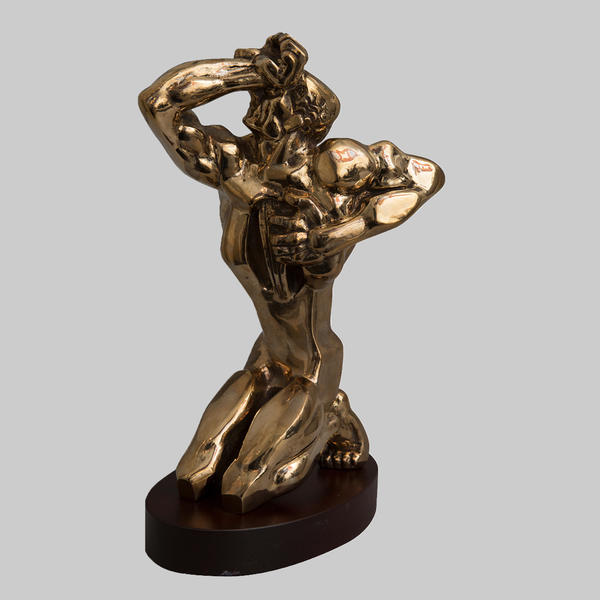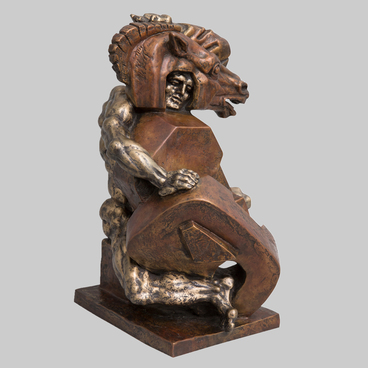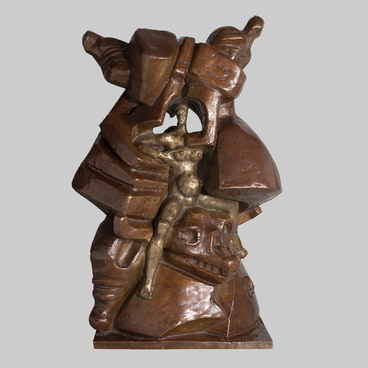The famous statue Orpheus was created by Ernst Neizvestny in 1995 according to a model made in 1962. The work became a prize statuette of the TEFI awards, annually presented by the Academy of Russian Television Foundation to notable figures in television arts. It is considered an analogue of the American Emmy Awards.
The original Orpheus figure is stored in the United States and has a height of 2 m. Scaled bronze copies are used as awards to cinema workers, each weighing 8.5 kg. Prizes are made in the workshop of the American sculptor Jeff Bliumis - a student of Ernst Neizvestny. The value of each statue is approximately $ 1,000 US.
The statue depicts a hero of ancient Greek mythology. According to the legend, the singer and musician Orpheus received a golden lyre as a gift from the God Apollo, the sounds of the lyre had a magical effect on the listeners. Music helped him win the love of the beautiful Eurydice. Happiness did not last long, the wife was accidentally bitten by a snake and died.
Orpheus descends for his beloved into the underworld and persuades the gods to let his wife go. However, the musician violated the only condition of the agreement - he looked at Eurydice before they rose to the surface of the earth. The woman forever returned to the kingdom of shadows. The inconsolable singer, having lost his beloved, in a fit of grief tears apart his chest and plays the last song on the strings of his soul.
The figure was created by Ernst Neizvestny under the influence of deep emotions after the scandalous exhibition in the Moscow Manege 30 Years of the Moscow Artists' Union The head of state, Nikita Sergeyevich Khrushchev, was present at the vernissage and mercilessly, without choosing expressions, criticized the avant-garde works of the master, calling them ‘degenerative art’. The emotional unrest of the artist was embodied in the image of Orpheus. The sculpture was created in one night from clay and gypsum and later, after emigration, it was recreated in bronze in the USA. Vladimir Vladimirovich Pozner saw the work of art and suggested that the author transforms it into a prize for the Academy of Russian Television.
The figure symbolizes the artist’s struggle with insurmountable obstacles, his despair, his willingness to give his life for art, for the opportunity to create and express his thoughts and feelings. It is noteworthy that during the years of World War II, the sculptor was wounded in the chest, after which he barely survived. Since then, the experiences that he underwent, memories of pain, wounds are repeatedly reflected in the work of the master.
The sculpture Orpheus carries a combination of styles: realism, symbolism and expressionism. The figure of the hero is distinguished by an amazing anatomical accuracy, deep emotionality and expressiveness.
After the unsuccessful exhibition, Ernst Neizvestny stopped receiving orders. Of the 850 works created over the next 15 years, he managed to sell only 4. In 1976, the master emigrated from the country, as he himself explained, “because of aesthetic differences with the regime”.
The original Orpheus figure is stored in the United States and has a height of 2 m. Scaled bronze copies are used as awards to cinema workers, each weighing 8.5 kg. Prizes are made in the workshop of the American sculptor Jeff Bliumis - a student of Ernst Neizvestny. The value of each statue is approximately $ 1,000 US.
The statue depicts a hero of ancient Greek mythology. According to the legend, the singer and musician Orpheus received a golden lyre as a gift from the God Apollo, the sounds of the lyre had a magical effect on the listeners. Music helped him win the love of the beautiful Eurydice. Happiness did not last long, the wife was accidentally bitten by a snake and died.
Orpheus descends for his beloved into the underworld and persuades the gods to let his wife go. However, the musician violated the only condition of the agreement - he looked at Eurydice before they rose to the surface of the earth. The woman forever returned to the kingdom of shadows. The inconsolable singer, having lost his beloved, in a fit of grief tears apart his chest and plays the last song on the strings of his soul.
The figure was created by Ernst Neizvestny under the influence of deep emotions after the scandalous exhibition in the Moscow Manege 30 Years of the Moscow Artists' Union The head of state, Nikita Sergeyevich Khrushchev, was present at the vernissage and mercilessly, without choosing expressions, criticized the avant-garde works of the master, calling them ‘degenerative art’. The emotional unrest of the artist was embodied in the image of Orpheus. The sculpture was created in one night from clay and gypsum and later, after emigration, it was recreated in bronze in the USA. Vladimir Vladimirovich Pozner saw the work of art and suggested that the author transforms it into a prize for the Academy of Russian Television.
The figure symbolizes the artist’s struggle with insurmountable obstacles, his despair, his willingness to give his life for art, for the opportunity to create and express his thoughts and feelings. It is noteworthy that during the years of World War II, the sculptor was wounded in the chest, after which he barely survived. Since then, the experiences that he underwent, memories of pain, wounds are repeatedly reflected in the work of the master.
The sculpture Orpheus carries a combination of styles: realism, symbolism and expressionism. The figure of the hero is distinguished by an amazing anatomical accuracy, deep emotionality and expressiveness.
After the unsuccessful exhibition, Ernst Neizvestny stopped receiving orders. Of the 850 works created over the next 15 years, he managed to sell only 4. In 1976, the master emigrated from the country, as he himself explained, “because of aesthetic differences with the regime”.



